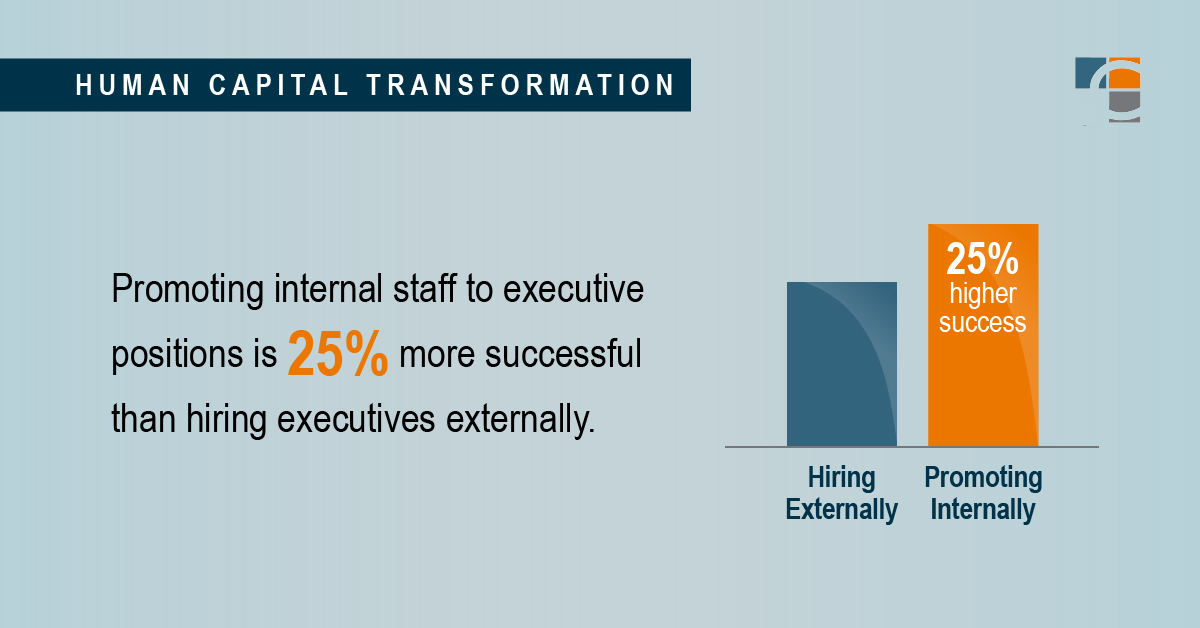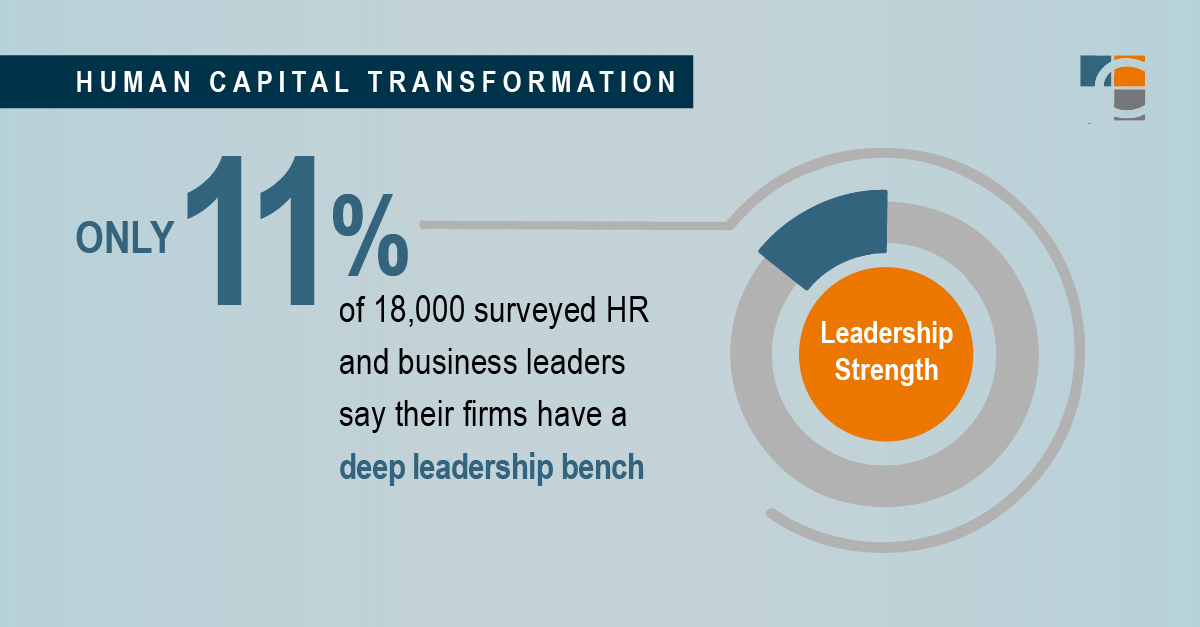A recent survey of nearly 18,000 Human Resources executives and business leaders shed light on the challenges to developing the next generation of leaders within organizations.
Only 11% of respondents said their companies had a “strong” or “very strong” leadership bench. That figure has been on the decline for a decade. A lack of depth can seriously hamper growth efforts, as sustainable scalability will hinge upon creating new, in-demand roles, backfilling positions previous leaders have outgrown, and designing a repeatable development framework for the future.

While a scarcity of leaders internally is an issue, survey data showed that promoting internal staff (emerging leaders) to executive positions is 25% more successful than making an external executive hire.
Leadership development programs are often underfunded or nonexistent. However, organizations cannot achieve scalability without an effective leadership pipeline.
What Is a Leadership Development Program?
A leadership development program is an organizational framework by which HR leaders and departmental heads facilitate, support, and invest in the maturation of top-performing employees. The goal is to prepare individual staff members to become leaders and executives in the future, arming them with the skills, traits, and education they need to be successful for the business and its people.
As companies experience rapid growth, it becomes increasingly difficult to scale leadership within the organization. A leader who was very successful with only five direct reports may not have the skills and abilities to quickly adapt and manage 15 people.

Additionally, if your company’s growth is accelerating, you’re likely to hire new managers from outside the company out of necessity. Unfortunately, these new leaders will not be aware of culture, internal processes, or leadership expectations immediately, so they often struggle to get oriented quickly.
Leadership development programs are critical to scaling company growth, retaining key talent, and maintaining company culture.
Enhance the Experience for New Leaders
The most immediate improvement an organization can make in the name of leadership development is prioritizing development opportunities for new leaders. This holds for leaders promoted from within or who are hired externally.
Three key leadership training points are imperative here:
1. Training Must Cover the Fundamentals
Existing company values and culture should influence the types of leaders needed and the qualities they need to exhibit. For example, Leader A must not approach the job (and direct reports) 180 degrees differently than Leader B or contradictorily to company culture. Employees deserve a consistent experience with different leaders.
A leadership style that runs counter to company values creates discord and undermines the ability to scale the business. Experience with leadership is an important element of the employee experience, and inconsistent or negative experiences can fuel employee disengagement, leading to turnover.
The fundamentals also include short-term objectives. When growing quickly, the amount of work can seem daunting to a new leader. Break down responsibilities and priorities into achievable action items with measurable timelines and outcomes.
Policies and processes evolve with a rapidly growing company, meaning communication around evolving expectations of leaders must be a priority.
While the leaders are focused on accomplishing tangible business results, they’ll also need time to develop and enhance adjacent, functionally critical leadership skills, like interpersonal rapport, supporting systems, and decision-making process norms.
2. Onboarding Must Not Be Over-Engineered
A simple process beats complexity every time, even if there’s good intent behind that complexity.
Gallup found that “for many employees, the most valuable aspect of their onboarding journey was simply how it was organized and delivered.”
An easy and intuitive onboarding program for leaders can help shorten learning curves, increase time-to-productivity, and set them on a path toward making a bigger impact at a critical junction in the company’s history.
Human resources information systems (HRIS) and human capital management (HCM) software can drive the onboarding experience through self-service functionality, on-demand learning modules, and other features that don’t require HR intervention. Staff can meet required training benchmarks in a timely manner and complete non-critical training at their own pace.
3. Onboarding Must Be Easily Adapted
As the business changes, the people, processes, and tools currently in use will be ever-evolving.
Onboarding materials must be easily manipulated as the environment expands, and it should require minimal administrative overhead to update such materials.
Delegate the responsibility for scaling and updating documents to multiple subject matter experts internally so that there are no process bottlenecks.
Consistently Engage All Levels of Leadership
Executives often forget that the various levels of leadership within a company also need to be nurtured and developed to remain engaged. In many ways, micro leadership development programs devoted to managers, another to directors, and another to senior leaders may be conducive to larger organizations with many tiers of management. This framework would of course roll up into the larger initiative.

Establishing ongoing professional development opportunities for managers as part of the learning and development program is equally important to developing robust development programming.
Additionally, leadership needs to ensure the expectations of leaders are consistently communicated. There are policies and processes that all leaders within a company are expected to uphold – going back to the fundamentals.
As those policies and processes evolve with a rapidly growing company, communication around the evolving expectations of leaders needs to be a priority.
To ensure consistency in leadership during hypergrowth, consider the three following components of a leadership development program:
1. Regular Meetings
Monthly meetings with all people in your company that hold a supervisory position are a baseline. Use this time to help them get to know one another, share recent news about the company, allow them to have facetime with the C-suite, and ask for their input.
These monthly meetings can be broken out further into subsequent weekly departmental meetings to allow for even closer collaboration.
2. Buddy Program
Assign new managers to meet regularly with a more tenured manager so there is a natural contact to help reinforce leadership values and expectations. This also allows the new manager an opportunity to begin building their internal network.
A buddy program facilitates honest conversations outside traditional reporting structures, so managers don’t have to worry about misspeaking, being perceived the wrong way, or failing on the job in front of their boss.
3. Communities of Practice
Communities of practice empower managers to tackle similar passions or pain points in a constructive way. They can be a powerful way to share knowledge, integrate best practices, and standardize company messaging for all managers.
Build focus groups around common, department-agnostic manager tasks, like mentorship, coaching, and teambuilding. Sessions of this kind are broad and useful enough for all to benefit.
Each session should have an assigned topic facilitated by HR or someone from within the learning and development program.
Ultimately, Leaders Are Accountable
When the company is quickly and repeatedly infused with new hires, new quotas, and new policies while scaling, underlying culture and division of duties can become murky.

Scaling at the expense of experience and culture sends the message that business leaders are focused on the road ahead and not the current realities of the employees enabling business success. This is an easy recipe for burnout and churn.
For a leadership development program to be successful, the company needs to define the core competencies by which managers, directors, and executives will be evaluated – and then follow through on the evaluation side of the equation.
To maintain a thriving culture during hypergrowth, leadership must prioritize developing key leaders at all levels of the company, building ongoing engagement opportunities, and holding all levels of management accountable so the employee experience is consistent and positive.
For expert support in scaling your business and its leaders, contact the Human Capital Transformation specialists at CrossCountry Consulting.